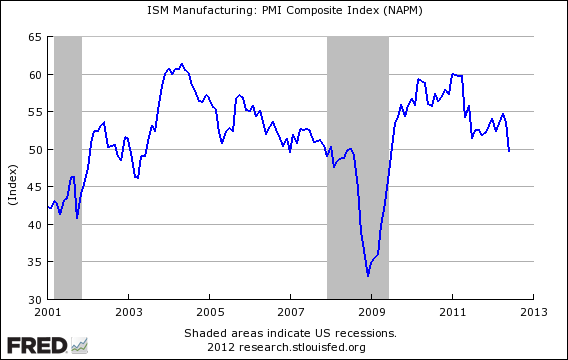The global slowdown is definitely being felt at home. U.S. manufacturing activity shrank in June for the first time in almost three years, according to a report released Monday, adding to the talk that the Federal Reserve will initiate a third round of quantitative easing in September to help support a flagging economy.
The Institute of Supply Management’s index of manufacturing activity fell to 49.7 percent, a drop of 3.8 percentage points from May and below the expected 52 percent. Index readings below 50 indicate contraction. The June report marks the first time the ISM figure has fallen below that level since July 2009, the month after the Great Recession officially ended.
RELATED: Why Most U.S. Manufacturing Jobs Are Gone Forever
“Cue hysteria,” wrote Ian Shepherdson, chief U.S. economist at High Frequency Economics, in a note to clients pointing out that an index level below 50, while a sign of contraction, does not indicate the economy is in recession. Index readings in the low 40s would indicate a full-fledged recession. The June level of 49.7, meanwhile, “corresponds to a 2.4 percent increase in real GDP annually," Bradley J. Holcomb, the chair of the Institute for Supply Management’s Manufacturing Business Survey Committee, said in a release announcing the latest figures.
“We are not yet in recession territory,” Nigel Gault, chief U.S. economist at IHS Global Insight, wrote to clients. “But manufacturing looks becalmed in the face of global headwinds, and overall growth in output and employment is likely to remain at a very modest pace.”
Most troubling, according to analysts, was the index of new orders, which fell from 60.1 in May to 47.8 in June, the largest such drop since October 2008 – and a sign that the manufacturing sectors’ challenges could continue. “That's a monumental decline,” Shepherdson wrote – bigger than any such plunge during the financial crisis “and only one-tenth less than the plunge after 9/11.”
The new orders index has given “plenty of false recession signs” in the past, Bank of America Merrill Lynch economists wrote in a note to clients. “That said, we are particularly concerned about today’s drop because it likely reflects a pullback by business as the Eurozone falls into a deeper recession and concern [continues] over the fiscal cliff. The manufacturing sector is particularly vulnerable to the slowdown in global activity.”
“The report suggests that for the moment the manufacturing recovery is out of steam – domestic demand growth is not sufficient to outweigh the headwinds from Europe and China,” Gault wrote.
RELATED: Home Prices Rise, But Consumer Confidence Falls
The wretched ISM report again turned analysts’ focus to the Federal Reserve, which last month cut its growth forecast for the year to as low as 1.9 percent, and the prospects for a third round of quantitative easing, or QE3. “The Fed is likely watching the manufacturing sector very closely as it is one of the first sectors of the economy to turn,” the Bank of America Merrill Lynch economists wrote. “Today’s report raises the likelihood that the Fed will take additional monetary policy action in the months ahead. We expect the Fed to launch QE3 at its September meeting.”




